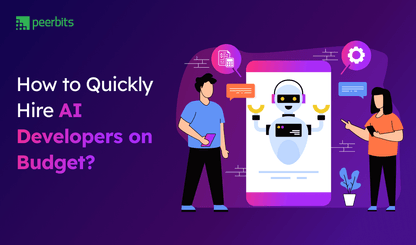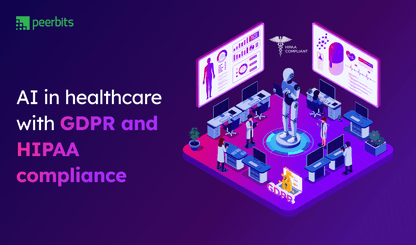Most companies today aren’t asking what is AI? anymore. Such a phase is long gone. The real challenge nowadays is which AI tools actually benefit us?
As AI integration becomes more accessible and focused on business outcomes, companies are under pressure to choose the right AI tools and AI platforms for business. The problem is, choosing the wrong AI integration tools can lead to wasted budgets, slowed projects, and resistance from teams expected to adopt them.
Well, the pressure is unlikely to ease in the near future. According to Grand View Research, the global artificial intelligence market was valued at USD 279.22 billion in 2024, and it’s projected to grow at a CAGR of 35.9% from 2025 to 2030. When the market moves this fast, a single wrong tool or rushed integration can set teams back by months.
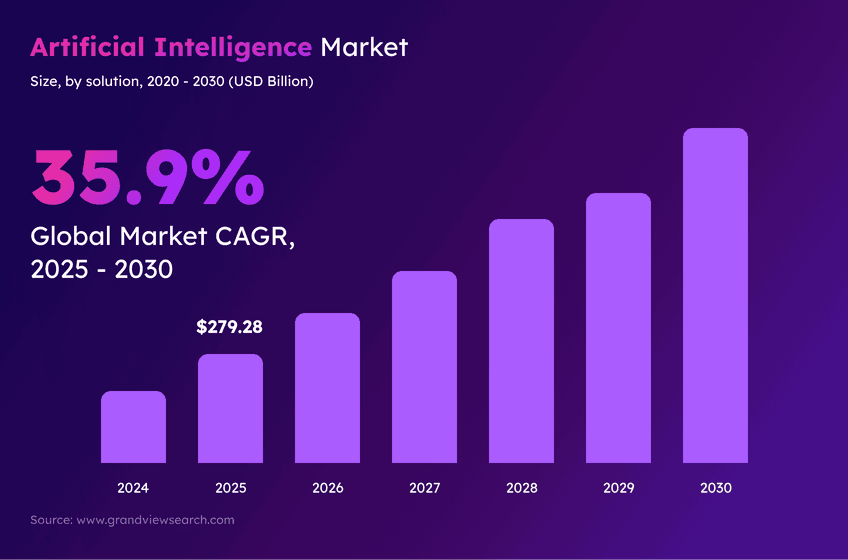
Whether it's AI tools for customer service, automation, or knowledge management, the difference often comes down to how well businesses evaluate before integrating.
Let’s see why thoughtful evaluation of AI tools is crucial for staying competitive and avoiding missteps that slow AI integration progress.
Why tool evaluation matter more than the AI model itself?
Even the smartest AI model won’t help if the tool built around it doesn’t match your business flow. Without proper AI integration services, you risk low adoption, frustrated teams, and wasted investment.
For example, using GPT with a clunky interface or a chatbot that lacks CRM connectivity won’t solve your core problems. It is about model accuracy and how well the tool fits into your ecosystem.
That is where evaluating AI tools becomes more important than just choosing an impressive model. The tool’s structure, its connection with your existing stack, and how it fits into daily workflows, all of that decides if AI becomes a help or a headache for you.
A well-built AI model can still fall flat if the tool built on top of it doesn’t align with your business needs. Here’s what that disconnect looks like:
- You get a top-tier LLM, but the tool’s interface frustrates your internal teams, so they stop using it.
- You deploy a smart chatbot, but without CRM integration, it creates more work than it saves.
- You invest in automation, but the tool can’t sync with your workflows or data sources.
Whether you're looking at AI tools for automation, customer service, or AI business integration, choosing the right tool is a business decision that affects daily operations, not just a technical upgrade.
Types of AI tools and platforms you should know
Before making any decisions, it’s helpful to understand the different types of AI tools and platforms you’re likely to encounter. This clarity can help you evaluate which options match your business needs, team capabilities, and long-term goals.
Each type brings its own strengths and trade-offs, so knowing what’s out there early on leads to smarter choices.
AI Integration tools you should know
When evaluating AI integration tools for your business, it’s essential to understand the range of options available. Whether you're looking to implement ready-made tools or considering platforms for custom development, knowing the difference can make your decision-making process smoother.
Below, we’ll look at some common tools and their roles in AI integration.
AI Tools for business integration/ Types of AI tools
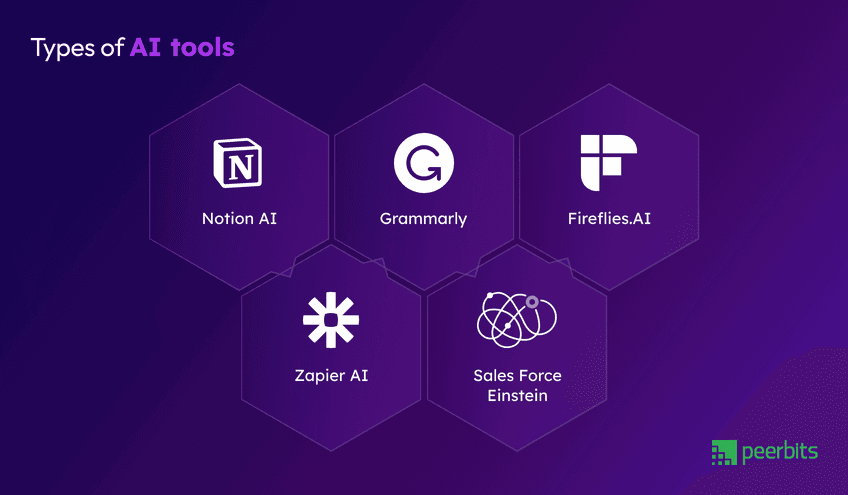
These AI tools for business are pre-built solutions designed to integrate specific AI capabilities into your existing operations. They provide quick setups and out-of-the-box functionalities that can help you optimize workflows, enhance customer support, and automate repetitive tasks without requiring heavy development work.
| Tool type | Description | Examples | Best fit for |
|---|---|---|---|
| AI SaaS integration tools | Tools that are ready-to-use for integrating AI into your workflow with minimal configuration. | Notion AI, Grammarly, Fireflies.ai | Small businesses or teams looking for fast implementation |
| AI tools for customer support integration | Tools that automate customer service and integrate with your CRM for seamless communication. | Intercom with Fin, Ada, Forethought | Customer support teams aiming for streamlined operations |
| AI tools for automation integration | Tools that automate repetitive tasks, data entry, and internal processes through AI. | Zapier AI, UiPath, Bardeen | Businesses looking to automate low-value tasks |
| AI tools for knowledge management integration | AI solutions that help businesses organize, search, and manage knowledge efficiently. | Glean, Guru, Bloomreach | Knowledge-heavy businesses, e.g., legal, consulting firms |
| AI tools for enterprise integration | Scalable AI tools that integrate with enterprise systems for large teams and complex processes. | Salesforce Einstein, Zoho Zia | Enterprises with complex operations looking for AI-driven solutions |
AI Platforms for Business Integration

AI integration platforms offer a deeper level of customization and flexibility compared to standalone tools. These platforms provide frameworks, APIs, and services for building, deploying, and managing AI-powered applications that can seamlessly integrate with your existing tech stack. While they require more technical expertise, they’re ideal for businesses with specific integration needs or custom AI workflows.
| Platform type | Description | Examples | Best fit for |
|---|---|---|---|
| Horizontal AI platforms | General-purpose AI platforms that offer flexibility for building and deploying a variety of AI models. | OpenAI, Cohere, Anthropic | Companies with technical teams who need adaptable, broad AI solutions |
| Vertical-specific AI platforms | Industry-specific AI platforms offering advanced functionality for particular business needs. | Viz.ai (healthcare), Replit Ghostwriter (dev), Pymetrics | Businesses in specialized sectors needing custom AI integration |
| AI platforms with prebuilt Integrations | Platforms that provide easy integration with other software tools and platforms, streamlining deployment. | Microsoft Copilot, AWS Bedrock, Google Vertex AI | Enterprises seeking scalable, plug-and-play AI solutions |
| Developer-first AI platforms | Platforms providing the tools and APIs needed to build custom AI models and applications. | LangChain, Haystack, Hugging Face Transformers | Developers and technical teams building tailored AI solutions |
| Hybrid AI integration platforms | Platforms combining easy-to-use tools with customization options for specific business needs. | Zapier AI + OpenAI, Glean | Businesses seeking both simplicity and flexibility in AI integration |

Key factors to evaluate before integrating any AI tool
Before jumping into AI integration, it’s important to look beyond flashy demos or feature checklists. A tool that looks great in a pitch might fall short in practice if it doesn't align with your real needs.
Here's how to break down the evaluation process smartly:
1. Match the AI tool to the real business need
Think about what the tool is meant to do. Is it solving a current bottleneck? Is it supporting an existing workflow or replacing something entirely? A strong use-case fit is the first filter for any AI integration.
2. Look for integration-ready architecture
A good AI integration tool fits into your stack without friction. Whether you use a CRM, ERP, ticketing systems, or Slack, check for native integrations or solid APIs. Mature APIs and developer support will save time and reduce headaches later.
3. Treat data security as non-negotiable
Not every AI platform handles data the same way. Understand where your data flows, where it’s stored, and how it’s protected. Look for SOC2 or GDPR compliance, and verify if on-prem deployment is an option if your enterprise needs it.
4. Prioritize tools with transparent and accurate outputs
Accuracy matters, but so does explainability, especially in customer-facing or compliance-heavy environments. If an AI tool generates results without context or logic, it may be hard to trust, fix, or defend.
5. Choose tools your teams will actually use
Slick UI isn’t just nice-to-have. Adoption depends on how intuitive the tool feels to your actual users. If non-technical teams hesitate or avoid it, even the best AI tool loses its impact. Frictionless UX is key.
6. Understand the pricing and value logic clearly
Flat-rate pricing vs usage-based? Either can work, but you should know what you’re paying for and what it replaces. Some tools seem affordable until usage spikes, while others replace multiple manual tasks and deliver ROI fast.
Run a proof of concept before full AI integration
Jumping straight from a vendor demo to full rollout can create more issues than solutions. Running a proof of concept (POC) with your own data and workflows helps uncover the truth beyond the marketing.
What to include in a smart POC
- Use real business scenarios, not canned examples
- Involve internal users to gather meaningful feedback
- Check how the tool handles errors and unusual cases
- Track time saved, accuracy gains, or process improvement
What a good POC helps reveal
- Technical gaps in compatibility or workflow fit
- Hidden costs that show up during actual usage
- User resistance caused by poor UX or confusing outputs
Whether you're testing AI tools for automation, customer service, or knowledge management, a well-run POC builds confidence before scaling. It also supports better decisions when comparing AI integration platforms or choosing between build vs buy AI models.
Okay, so what are some top tools worth testing?
Popular AI tools and platforms worth evaluating in 2025
With so many AI integration tools in the market, choosing the right one isn't about chasing trends. It's about finding what fits your business needs. This list isn't a ranking, but a practical grouping to help you shortlist tools based on use case.
Customer support and chatbot AI tools
AI chatbot tools are now central to handling first-level queries, reducing support load, and speeding up response times. These platforms plug into helpdesk systems and help teams maintain consistent customer service without scaling headcount too fast.
- Intercom Fin: Built on GPT-4, good for scaling chat support with fallback to agents.
- Zendesk AI: Native AI layer on top of the Zendesk stack, supports macros, intent detection, and routing.
- Freshchat + Freddy: Works well for small to mid-sized teams, connects easily with other Freshworks products.
- Ada: Focuses on enterprise-grade automation and multilingual support.
Read more: AI Chatbots for Customer Service: 24/7 Instant Support Revolution
Knowledge management and internal search tools
- Glean: AI-powered enterprise search across your tools; good for fast, unified access to knowledge.
- Guru AI: Combines knowledge cards with AI suggestions; great for onboarding and support teams.
- Stonly: Useful for step-by-step internal guides powered by AI-generated suggestions.
Internal automation and operations tools
Used to reduce repetitive workflows, trigger actions, and integrate data across tools using AI layers.
- Zapier AI: Adds generative AI to build workflows with natural language.
- Make + OpenAI: Visual automation builder with OpenAI steps; useful for custom data tasks.
- Workato AI plugins: Enterprise automation with AI-infused logic and deeper governance options.
- Marketo: Marketo email marketing tool can be effectively used as an internal automation and operations tool, particularly within marketing, sales, and analyzing email campaigns.
Document analysis and summarization tools
Best for teams dealing with contracts, reports, or any document-heavy process that needs speed and accuracy.
- Microsoft Copilot: Embedded in Office 365; summarization, drafting, and doc insights.
- Hyperscience: Built for structured document processing at scale; includes ML-powered data extraction.
- Writer.com: AI platform for content, compliance, and grammar at an enterprise level.
Developer-first platforms for custom AI builds
If you need tailored workflows or want to integrate AI into your product or stack, these tools are the base.
- OpenAI APIs: Foundation models like GPT-4 and DALL·E for NLP, image, and custom workflows.
- LangChain + vector DBs: Flexible stack to build RAG and custom AI agents.
- Google Vertex AI: Offers model training, deployment, and pipeline tools with deep GCP integration.
- AWS Bedrock: Supports multiple foundation models with security and scaling features.
- Cohere RAG stack: Optimized for retrieval-augmented generation and enterprise-level search use cases.
Building vs buying AI: What actually fits your business?
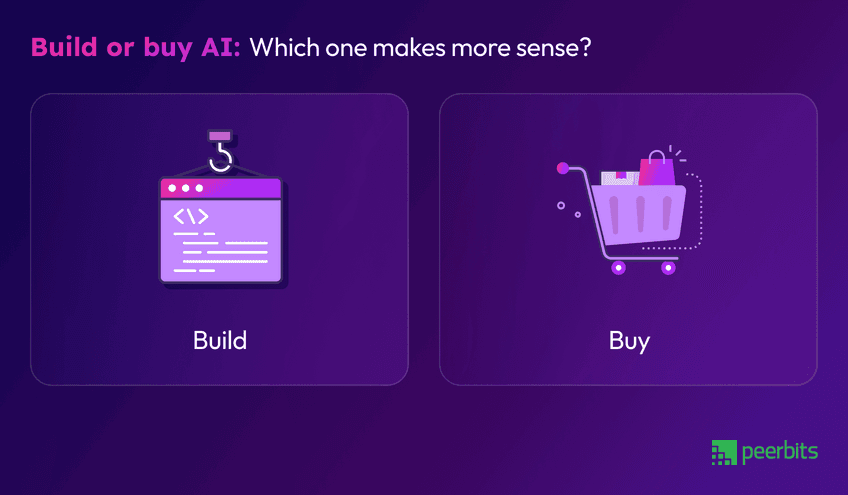
Choosing between building your own AI tools or buying off-the-shelf solutions depends on how unique your needs are and how fast you want results. Many companies explore this through AI consulting services to evaluate both sides clearly.
Building gives you:
More control and flexibility. It's ideal when you need tighter integration with your systems or want to shape AI tools around your workflows.
- Custom workflows that match your operations
- Ownership over data pipelines
- Easier scaling as needs grow
- Better alignment with long-term tech goals
Buying gives you:
Speed and convenience. It helps when you're experimenting or need quick results with minimal setup.
- Faster deployment
- Lower entry cost
- Proven tools with vendor support
- Good for standard use cases or pilots
Sometimes, the smarter move is blending both, using APIs or open-source components to create lightweight custom layers without heavy development.
Why choose Peerbits for AI integrations
Peerbits brings deep expertise in AI development services, helping businesses move from experimentation to practical, production-ready solutions. Our team includes certified professionals, including AWS AI Practitioners, who guide every stage of AI integration with clarity and precision.
We don’t just plug in AI tools, instead we develop AI solutions that align with your business needs. From improving internal processes to enhancing customer experiences, we help you create systems that deliver measurable outcomes.
Our AI services and solutions include:
- End-to-end AI development tailored to specific use cases
- Custom chatbots and virtual assistants
- Document analysis and summarization using LLMs
- Integration with CRM, ERP, and collaboration tools
- RAG-based internal search and knowledge systems
- NLP-driven insights and predictive analytics
- Scalable MLOps and post-deployment support We focus on long-term value, with AI systems that are easy to maintain, secure, and designed for real adoption across teams.
Conclusion
AI integration is a business shift that touches workflows, teams, and decision-making, as it is not just a tech upgrade. Well, the tools you choose and how you evaluate them can impact everything from internal adoption to long-term ROI.
When we are talking or making business decisions, avoid getting pulled into demos or flashy features. So, what matters more? Clarity! Does this solve your core problems? Most importantly, Will your people actually use it?
If you're planning a proof of concept or deciding whether to build or buy, focus on what fits your team’s actual workflows and goals, not just what sounds impressive on paper.
Careful evaluation upfront helps you avoid hidden costs, poor adoption, and missed outcomes. In many cases, working with a team that has hands-on experience in AI integration can save time, reduce risks, and guide you toward more sustainable results.

FAQ's
Timelines vary based on complexity, but most mid-sized AI integrations take 4 to 12 weeks. This includes vendor/tool evaluation, proof of concept, integration with existing systems, and internal testing.
Rushing into tools based on hype, ignoring integration feasibility, overlooking team readiness, and underestimating post-deployment maintenance are common pitfalls.
Not necessarily. With the right AI consulting services or managed solutions, external experts can handle setup, monitoring, and updates while your internal team focuses on business logic.
They can be, especially for organizations with technical teams. Open-source solutions give more control but may require extra work on security, scalability, and maintenance.
Data privacy, compliance (like GDPR or HIPAA), model transparency, and vendor reliability are all key. Always review how data flows between systems and who retains ownership.


